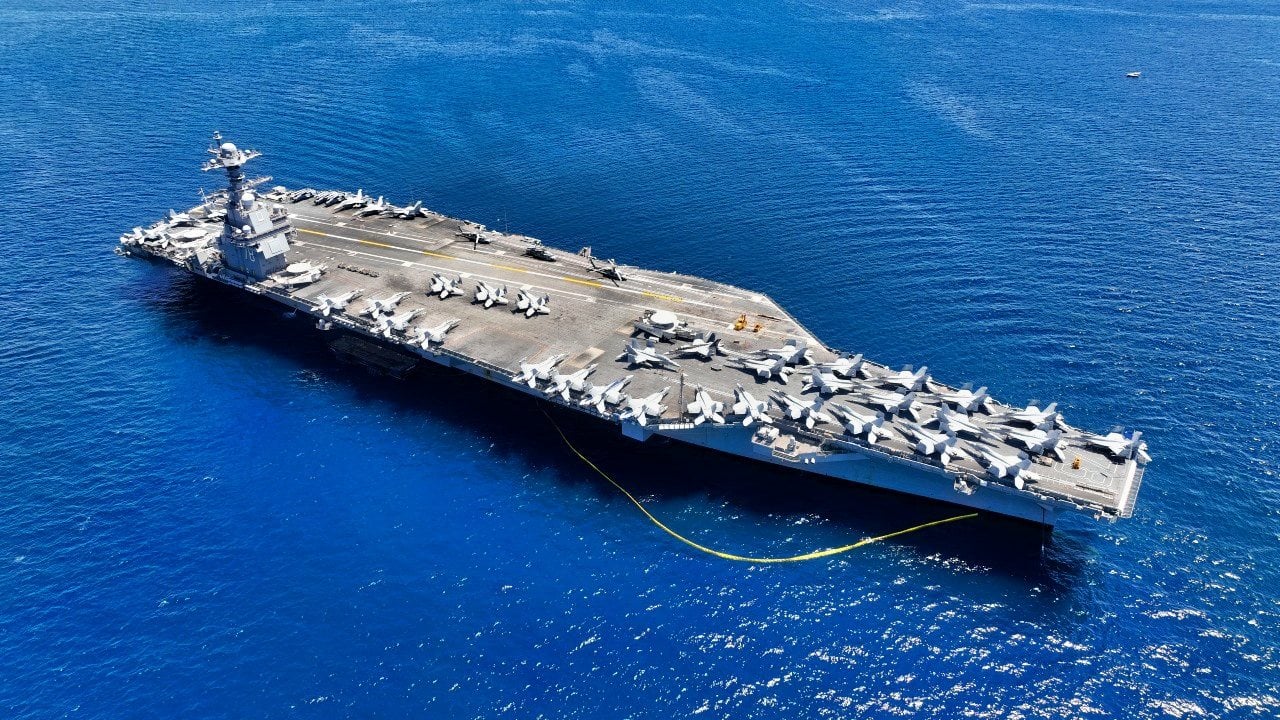China Is Flexing Some Serious Aircraft Carrier Muscles
Chinese state media program Military Time highlighted the progress made to the People's Liberation Army Navy's (PLAN's) second domestically-built aircraft carrier Fujian.
Is China's Newest Aircraft Carrier Superior to America's Best? - Chinese state media program Military Time highlighted the progress made to the People's Liberation Army Navy's (PLAN's) second domestically-built aircraft carrier Fujian. The flattop was launched in June 2022 and is part of Beijing's goal of having a "blue-water" navy capable of projecting power far beyond China's coasts.
The military affairs program, which airs on Chinese state broadcaster CCTV, reported that there has been significant progress made on the insulation of the vessel's electromagnetic catapult launch system. It was the second time in a month that footage of the catapult has been shown on TV, signaling the progress that has been made on the carrier.
The United States Navy's nuclear-powered USS Gerald R. Ford (CVN-78) is the only other aircraft carrier in the world equipped with electromagnetic catapults – the Electromagnetic Aircraft Launch System (EMALS). The PLAN's Fujian is just the aircraft carrier featuring an advanced catapult launch system, even as the warship is conventionally powered.
The carrier was also designed without the ski-jump, it offers more operational space on deck than the PLAN's two operational carriers, the Soviet-designed Liaoning and the Shandong, The South China Morning Post reported.
"The aircraft mock-up in the images is to test how many carrier-based aircraft can be parked on the elevator at any one time and the full-load speed; how to take-off and land, how to maneuver on the aircraft carrier after the wings are unfolded; how to launch aircraft and how many aircraft to launch and so on while refueling and regassing," said Cao Weidong, a former PLA Navy senior colonel and ex-military attaché at the Chinese Embassy in the United Kingdom, per Newsweek.
"This is the first aircraft carrier in the world to use conventional power for electromagnetic catapult take-offs," Cao added.
Better Than the Ford-Class U.S. Navy Aircraft Carrier?
Chinese military analysts have also suggested that the PLAN's carrier could have a significant advantage over the U.S. Navy's newest class of carriers – namely in their respective masts.
As The South China Morning Post also reported, while the USS Gerald R. Ford features an island – the command center – with a towering mast with an array of antennas and sensors, those antennas are almost unseen on the Fujian. The island on Beijing's carrier is enclosed in a grey composite material, and utilizes the same minimalist design seen in many of the PLAN's latest warships, notably the Type 055 destroyer.

The technology behind the " multifunctional integrated electronic mast" was recently unveiled in a paper by scientists from the Nanjing Research Institute of Electronics Technology, where it was developed. Lead engineering scientist Li Shengyan has said that it could have a significant impact on warfare in the future.
The study noted how modern warship masts house antennas with three main functions – radar, electronic surveillance, and electromagnetic suppression – and that generally require antennas of different shapes. In addition to being exposed to the elements, which could make them vulnerable to weathering and performance degradation due to interference from other equipment, the traditional mast configuration has also been seen as detrimental to electromagnetic stealth, making the ship visible to enemy weapon systems from a distance.

Li's team is now seeking to develop an antenna array that can simultaneously perform radar scanning, signal interception, and electromagnetic suppression. Moreover, such a second generation of electromagnetic integration technology could be more easily encased in a warship's island and connected to a computer via a high-speed optical fiber. That could allow the operator to adjust the equipment and perform tasks by touching a screen but also reduce its radar signature.
The United States has also experimented with such a design, notably employing a concealed antenna integrated electromagnetic mast that was used on the US Navy's San Antonio-class amphibious transport dock more than two decades ago. In addition, a similar mast design was also utilized with the Zumwalt-class destroyer, but it was reportedly deemed too expensive and unnecessary. As a result, traditional masts continue to be used for most U.S. Navy vessels – including the Gerald R. Ford-class supercarriers.
Whether this technology could give the PLAN's carriers an edge isn't clear, but Beijing's ability to build warships faster than the United States, while also introducing the latest innovations should be a concern for the U.S. Navy.
Author Experience and Expertise: Peter Suciu
Peter Suciu is a Michigan-based writer. He has contributed to more than four dozen magazines, newspapers, and websites with over 3,200 published pieces over a twenty-year career in journalism. He regularly writes about military hardware, firearms history, cybersecurity, politics, and international affairs. Peter is also a Contributing Writer for Forbes and Clearance Jobs. You can follow him on Twitter: @PeterSuciu. You can email the author: [email protected].

